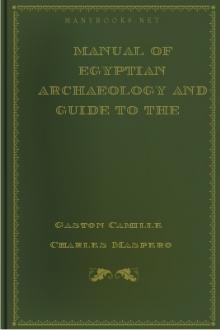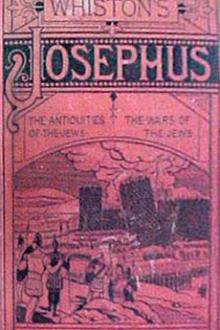Manual of Egyptian Archaeology and Guide to the Study of Antiquities in Egypt by Gaston Maspero (i have read the book txt) 📕

107. Wall-scene from temple of Denderah
108. Obelisk of Heliopolis, Twelfth Dynasty
109. Obelisk of Begig, Twelfth Dynasty
110. "Table of offerings" from Karnak
111. Limestone altar from Menshîyeh
112. Wooden naos, in Turin Museum
113. A mastaba
114. False door in mastaba
115. Plan of forecourt, mastaba of Kaäpir
116. Plan of forecourt, mastaba of Neferhotep
117. Door in mastaba façade
118. Portico and door of mastaba
119. Plan of chapel, mastaba of Khabiûsokari
120. Plan of chapel, mastaba of Ti
121. Plan of chapel, mastaba of Shepsesptah
122. Plan of chapel, mastaba of Affi
123. Plan of chapel, mastaba of Thenti
124. Plan of chapel, mastaba of Red Scribe
125. Plan of chapel, mastaba of Ptahhotep
126. Stela in mastaba of Merrûka
127. Wall-scene from mastaba of Ptahhotep
128. Wall-scene from mastaba of Ûrkhûû
129. Wall-scene from mastaba of Ptahhotep
130. Plan of serdab in mastaba at Gizeh
131. Plan of serdab and
Read free book «Manual of Egyptian Archaeology and Guide to the Study of Antiquities in Egypt by Gaston Maspero (i have read the book txt) 📕» - read online or download for free at americanlibrarybooks.com
- Author: Gaston Maspero
- Performer: -
Read book online «Manual of Egyptian Archaeology and Guide to the Study of Antiquities in Egypt by Gaston Maspero (i have read the book txt) 📕». Author - Gaston Maspero
The pyramids were supposed to have their four faces to the four cardinal points, like the mastabas; but, either from bad management or neglect, the greater part are not oriented exactly, and many vary distinctly from the true north (Note 18). Without speaking of the ruins of Abû Roash or Zowyet el Aryan, which have not been studied closely enough, they naturally form six groups, distributed from north to south on the border of the Libyan plateau, from Gizeh to the Fayûm, by Abûsîr, Sakkarah, Dahshûr, and Lisht. The Gizeh group contains nine, including those of Khûfû, Khafra, and Menkara, which were anciently reckoned among the wonders of the world. The ground on which the pyramid of Khûfû stands was very irregular at the time of construction. A small rocky height which rose above the surface was roughly cut (fig. 136) and enclosed in the masonry, the rest being smoothed and covered with large slabs, some of which still remain (Note 19). The pyramid itself was 481 feet high and 755 feet wide, dimensions which the injuries of time have reduced to 454 feet and 750 feet respectively. It preserved, until the Arab conquest, a casing of stones of different colours (Note 20), so skilfully joined as to appear like one block from base to summit. The casing work was begun from the top, and the cap placed on first, the steps being covered one after the other, until they reached the bottom (Note 21). In the inside all was arranged so as to hide the exact place of the sarcophagus, and to baffle any spoilers whom chance or perseverance had led aright. The first point was to discover the entrance under the casing, which masked it. It was nearly in the middle of the north face (fig. 136), but at the level of the eighteenth course, at about forty- five feet from the ground. When the block which closed it was displaced, an inclined passage, 41.2 inches wide and 47.6 inches high, was revealed, the lower part of which was cut in the rock. This descended for 317 feet, passed through an unfinished chamber, and ended sixty feet farther in a blind passage. This would be a first disappointment to the spoilers. If, however, they were not discouraged, but examined the passage with care, they would find in the roof, sixty-two feet distant from the door, a block of granite (Note 22) among the surrounding limestone. Fig 136.--Section of the Great Pyramid. Fig 136.--Section of the Great Pyramid. [30]
It was so hard that the seekers, after having vainly tried to break or remove it, took the course of forcing a way through the softer stone around (Note 23). This obstacle past, they came into an ascending passage which joins the first at an angle of 120° (Note 24), and is divided into two branches. One branch runs horizontally into the centre of the pyramid, and ends in a limestone chamber with pointed roof, which is called, without any good reason, "The Queen's Chamber." The other, continuing upward, changes its form and appearance. It becomes a gallery 148 feet long and 28 feet high, built of Mokattam stone, so polished and finely wrought that it is difficult to put a "needle or even a hair" into the joints (Note 25). The lower courses are vertical; the seven others "corbel" forwards, until at the roof they are only twenty-one inches apart. A fresh obstacle arose at the end of this gallery. The passage which led to the chamber of the sarcophagus was closed by a slab of granite (Note 26); farther on was a small vestibule divided in equal spaces by four portcullises of granite (Note 27), which would need to be broken. The royal sepulchre is a granite chamber with a flat roof, nineteen feet high, thirty-four feet long, and seventeen feet wide. Here are neither figures nor inscriptions; nothing but a granite sarcophagus, lidless and mutilated. Such were the precautions taken against invaders; and the result showed that they were effectual, for the pyramid guarded its deposit during more than four thousand years (Note 28). But the very weight of the materials was a more serious danger. To prevent the sepulchral chamber from being crushed by the three hundred feet of stone which stood over it, five low hollow spaces, one over the other, were left above it. The last is sheltered by a pointed roof, formed of two enormous slabs (Note 29) leaning one against the other. Thanks to this device, the central pressure was thrown almost entirely on the side faces, and the chamber was preserved. None of the stones which cover it have been crushed; none have yielded a fraction since the day when the workmen cemented them into their places (Note 30).
The pyramids of Khafra and Menkara were built on a different plan inside to that of Khûfû. Khafra's had two entrances, both to the north, one from the platform before the pyramid, the other fifty feet above the ground. Menkara's still preserves the remains of its casing of red granite (Note 31). The entrance passage descends at an angle of twenty-six degrees, and soon runs into the rock.
Fig 137.--The Step Pyramid of Sakkarah. Fig 137.--The Step Pyramid of Sakkarah.
The first chamber is decorated with panels sculptured in the stone, and was closed at the further end by three portcullises of granite. The second chamber appears to be unfinished, but this was a trap to deceive the spoilers. A passage cut in the floor, and carefully hidden, gave access to a lower chamber. There lay the mummy in a sarcophagus of sculptured basalt. The sarcophagus was still perfect at the beginning of this century. Removed thence by Colonel Howard Vyse, it foundered on the Spanish coast with the ship which was bearing it to England.
The same variety of arrangement prevails in the groups of Abûsîr, and in one part of the Sakkarah group. The great pyramid of Sakkarah is not oriented with exactness. The north face is turned 4° 21' E. of the true north. It is not a perfect square, but is elongated from east to west, the sides being 395 and 351 feet. It is 196 feet high, and is formed of six great steps with inclined faces, each retreating about seven feet; the step nearest the ground is thirty-seven and a half feet high, and the top one is twenty-nine feet high (fig. 137).
Fig 138.--Plan and Section of the Pyramid of Ûnas. Fig 138.--Plan and Section of the Pyramid of Ûnas.
It is built entirely of limestone, quarried from the neighbouring hills. The blocks are small and badly cut, and the courses are concave, according to a plan applied both to quays and to fortresses. On examining the breaches in the masonry, it is seen that the outer face of each step is coated with two layers, each of which has its regular casing (Note 32). The mass is solid, the chambers being cut in the rock below the pyramid. It has four entrances, the main one being in the north; and the passages form a perfect labyrinth, which it is perilous to enter. Porticoes with columns, galleries, and chambers, all end in a kind of pit, in the bottom of which a hiding place was contrived, doubtless intended to contain the most precious objects of the funeral furniture. The pyramids which surround this extraordinary monument have been nearly all built on one plan, and only differ in their proportions. The door (fig. 138, A) opens close below the first course, about the middle of the north face, and the passage (B) descends by a gentle slope between two walls of limestone. It is plugged up all along by large blocks (Note 33), which needed to be broken up before the first chamber could be entered (C). Fig 139.--Portcullis and passage, pyramid of Ûnas. Fig 139.--Portcullis and passage, pyramid of Ûnas.
Beyond this chamber, it is carried for some way through the limestone rock; then it passes between walls, ceiling and floor of polished syenite; after which the limestone re-appears, and the passage opens into the vestibule (E). The part built of granite is interrupted thrice, at intervals of two to two and a half feet, by three enormous portcullises of granite (D). Above each of these a hollow is left, in which the portcullis stone could be held up by props, and thus leave a free passage (fig. 139). The mummy once placed inside, the workmen, as they left, removed the supports, and the portcullises fell into place, cutting off all communication with the outside. The vestibule was flanked on the east by a flat-roofed serdab (F) divided into three niches, and encumbered with chips of stone swept hastily in by the workmen when they cleared the chambers to receive the mummy. The pyramid of Ûnas has all three niches preserved; but in the pyramids of Teti and of Merenra, the separating





Comments (0)